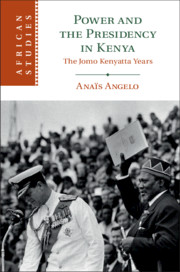Book contents
- Power and the Presidency in Kenya
- African Studies Series
- Power and the Presidency in Kenya
- Copyright page
- Dedication
- Contents
- Acknowledgments
- Introduction
- 1 Kenyatta’s Stateless Political Imagination
- 2 From Prison to Party Leader, an Ambiguous Ascension (1958–1961)
- 3 Kenyatta, Land, and Decolonization (1961–1963)
- 4 Independence and the Making of a President (1963–1964)
- 5 Kenyatta, Meru Politics, and the Last Mau Mau (1961/3–1965)
- 6 Taming Oppositions: Kenyatta’s “Secluded” Politics (1964–1966)
- 7 Ruling over a Divided Political Family (1965–1969)
- 8 “Kenyatta Simply Will Not Contemplate His Own Death” (1970–1978)
- Conclusion
- Sources
- Bibliography
- Index
- African Studies Series
3 - Kenyatta, Land, and Decolonization (1961–1963)
Published online by Cambridge University Press: 11 October 2019
- Power and the Presidency in Kenya
- African Studies Series
- Power and the Presidency in Kenya
- Copyright page
- Dedication
- Contents
- Acknowledgments
- Introduction
- 1 Kenyatta’s Stateless Political Imagination
- 2 From Prison to Party Leader, an Ambiguous Ascension (1958–1961)
- 3 Kenyatta, Land, and Decolonization (1961–1963)
- 4 Independence and the Making of a President (1963–1964)
- 5 Kenyatta, Meru Politics, and the Last Mau Mau (1961/3–1965)
- 6 Taming Oppositions: Kenyatta’s “Secluded” Politics (1964–1966)
- 7 Ruling over a Divided Political Family (1965–1969)
- 8 “Kenyatta Simply Will Not Contemplate His Own Death” (1970–1978)
- Conclusion
- Sources
- Bibliography
- Index
- African Studies Series
Summary
Chapter 3 focuses on the negotiations concerning the decolonisation of land. It analyses how the reshaping of land transfer institutions impacted both the decolonisation process and Kenyatta’s ascension to power. The setting-up of the Central Land Board in 1961 and the peaceful decolonisation of land was central to the independence conferences. The chapter argues that land negotiations prepared the way for a centralized government, even before the debate over federalism versus centralization was settled among the Kenyan political elite. It shows that the British fear of a security breakdown not only led to the creation of centralized institutions for land transfer, but also played a significant role in their favouring Kenyatta as a leader. By doing so, the British authorities abandoned both the European settler’ and the minority ethnic groups, who were arguing for majimboism (regionalism). At independence, Kenyatta would not only be considered the guardian of political order, he would also inherit an advantageously designed institutional framework to control the most valuable political and economic resource in Kenya: land.
- Type
- Chapter
- Information
- Power and the Presidency in KenyaThe Jomo Kenyatta Years, pp. 95 - 114Publisher: Cambridge University PressPrint publication year: 2019

